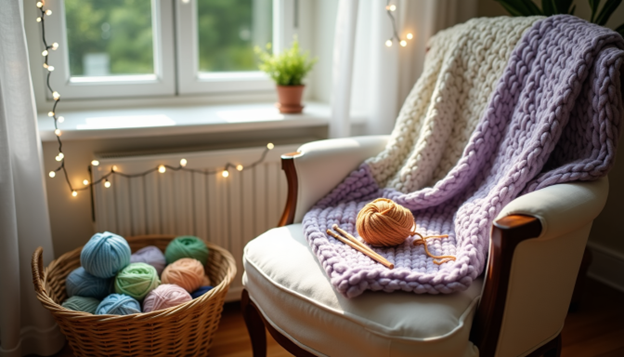I felt less alone when I found out that 74% of women dealing with anxiety said knitting helped calm their fears.
My relationship with knitting started during my most challenging mental health days. The changes I saw in myself were amazing.
The science backs up my experience about knitting’s benefits for mental health.
Mayo Clinic research shows that crafts like knitting can protect our brain function as we age. Studies prove it lowers stress hormones and boosts serotonin – our feel-good brain chemical.
A worldwide study of over 3,500 knitters also showed that people who knit regularly feel calmer and think more clearly.
Let me tell you my story about weaving knitting into my mental health routine. What I love is how it went from something I doubted to a powerful healing tool that’s now a key part of my daily self-care.
My Mental Health Struggle Before Discovering Knitting
My life changed completely after I found knitting. Before that, I battled with crippling anxiety and depression that touched every part of my life.
I wasn’t alone – about 20% of adults live with mental health disorders. Each day brought overwhelming worry and a deep sense of hopelessness.
Living with chronic anxiety and depression
My symptoms showed up as:
- Constant worry about everyday things that I couldn’t control
- Sleepless nights and feeling tired all the time
- A nagging feeling of being worthless
- Real physical pain like headaches and tense muscles
These problems made it harder to do my job well or keep up with relationships. The mix of anxiety and depression created a vicious cycle – both conditions kept feeding into each other.
Traditional therapy approaches I tried
Life pushed me to find different ways to get better.
Cognitive behavioral therapy (CBT) became my first step, which helped me spot negative thinking patterns.
We tried various medications and therapy methods, but something still felt missing from my recovery trip.
The unexpected suggestion that changed everything
My therapist surprised me with an unusual idea. Instead of another standard treatment, she told me about therapeutic knitting groups that healthcare professionals had recognized since 2006 for helping mental health.
The idea initially seemed strange – how could simple knitting help when nothing else worked?
Now I see why this suggestion came at just the right time. Studies show alternative therapy activities work best when you have professional mental health support.
This knowledge gave me the strength to try something new, even though I never saw myself as a crafty person.
How Knitting Benefits Transformed My Daily Life

The sound of knitting needles clicking became my daily meditation.
Research shows that repetitive motions of knitting can reduce heart rate and blood pressure by about 19%. This creates a natural calming effect that I needed badly.
Finding peace in repetitive motions
Knitting’s rhythmic movement became my anchor. Studies show that more than 80% of knitters feel happier after their knitting sessions.
I noticed this in my own experience. My racing thoughts would slow down when I focused on knitting’s steady rhythm “to a crawl.”
This helped me process one thought at a time instead of dealing with “20-30 threads at once”.
Creating structure through project planning
Knitting added structure to my daily routine. Each project worked like a roadmap – from picking yarn to following patterns. The craft gives you a perfect mix of creativity within safe boundaries. I started setting specific times to knit:
- Morning sessions with coffee to set a positive tone
- Evening knitting to unwind
- Weekend project planning for the week ahead
Building confidence through skill development
Learning new techniques boosted my confidence in ways I didn’t expect. The process taught me a lot about patience and perseverance. “Mistakes aren’t catastrophic,” became my mantra as I saw each error as a chance to grow.
My confidence grew with each project I finished. Research backs this up, showing that completing knitting projects helps improve self-esteem by a lot.
People’s appreciation for my finished pieces added extra validation, which created a positive cycle of creativity and confidence.
Integrating Knitting with Professional Mental Health Care
My therapist and I had a breakthrough. We decided to make knitting part of my treatment plan.
Research shows that knitting therapy has become a proven alternative to standard therapies, and my experience backs this up.
Working with my therapist to incorporate knitting
We arranged our sessions to include knitting as a complementary therapy.
Studies indicate that knitting can help reduce anxiety symptoms and increase overall sense of calm. My therapist taught me how to use this craft during challenging moments.
Using knitting as a mindfulness tool
I learned to use knitting as a mindfulness practice. Research shows that the repetitive, rhythmic nature of knitting can:
- Lower heart rate and blood pressure
- Reduce cortisol levels
- Clear the mind of stressors and distractions
“Mindfulness can be difficult to teach, especially when you have those who need it the most,” explains physiotherapist Betsan Corkhill.
Knitting became my gateway to mindfulness practice and made it available and practical.
Tracking mood changes through crafting sessions

I started tracking my emotional well-being through my knitting projects.
As with the findings from Bipolar Scotland, I found that there was mood tracking through crafting helped me identify triggers and communicate better with my healthcare providers.
This creative approach to mood tracking was a great way to get insights. Research showed that 54% of people with clinical depression reported feeling happy or very happy while knitting.
My experience matched these findings as I documented my emotional patterns through different projects.
Building a Sustainable Knitting Practice for Mental Health
My therapy turned into a lifestyle when I made knitting an eco-friendly practice. Research shows that a dedicated crafting space greatly improves knitting’s therapeutic benefits.
Creating a dedicated crafting space
I made my knitting sanctuary first.
A University of Gothenburg study shows that a well-laid-out environment helps bring calm to people with mental health problems. My setup has:
- A comfortable armchair near natural light
- Well-organized storage for yarns and needles
- Soft, ambient lighting for evening sessions
- Calming elements like plants and candles
Developing a daily knitting routine
A consistent practice schedule came next. Research shows that 35 minutes of knitting after breakfast can improve your day.
“Hands busy, mind focused” became my daily mantra. We switched my morning phone scrolling to knitting time, which led to more mindful mornings.
Balancing solo and group knitting experiences
The mix of alone time and social knitting changed everything.
Studies show that knitting groups are a great way to get emotional support and curb loneliness. Solo knitting gives you quiet reflection time, too.
My local knitting circle lets us share projects and stories, creating what one study calls a “low-stakes social context.” This mix of personal practice and community time is vital to my mental health trip.
Conclusion
Knitting therapy changed my life in ways I never expected. At first, I doubted its effectiveness, but this simple craft became my lifeline during tough times. Both science and my personal experience prove its healing power.
My life looks different now. I no longer fight anxiety alone. Solo knitting sessions and the warmth of my knitting circle give me peace of mind.
Research supports what I experienced – knitting helps reduce stress, builds confidence, and connects us with others who share this healing experience.
This craft showed me that mental health recovery takes unexpected paths. I found a sustainable approach to managing my mental health by combining professional therapy with mindful knitting. Every stitch moves me forward, brings peace, and adds to my ongoing wellness story.
I still face challenges, but my approach has changed. My knitting needles and newfound confidence help me understand that healing isn’t about reaching an endpoint. It’s about finding tools that help us direct life’s ups and downs with greater resilience and self-compassion.
